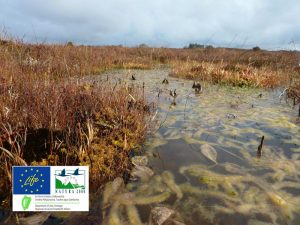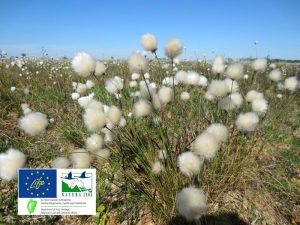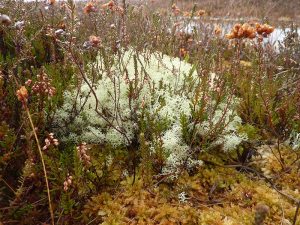Life on Carrowbehy / Caher Bog
The LIFE team are currently undertaking a comprehensive ground study at this beautiful Roscommon site. Results will be here at a later date.
In the meantime, the bog was most recently surveyed as part of the Raised Bog Monitoring & Assessment Survey 2013 (Fernandez et al). A similar survey was carried out in 2005 by Fernandez et al. (2005).
High bog vegetation was described and mapped, based on raised bog ecotope vegetation community complexes developed by Kelly and Schouten (2002).
Active Raised Bog covers 69.87 ha (34.16%) of the high bog area. The majority of this consists of the western raised bog central ecotope subtype, characterised by abundant, deep, mainly open-water pools with high hummocks of Sphagnum and Racomitrium lanuginosum. Flushed active peat forming areas included four soaks or small infilling lake complexes.

Degraded Raised Bog covers 134.69 ha (65.84%) of the high bog area. It is drier than Active Raised Bog and supports a lower density of Sphagnum mosses. It has a less developed micro-topography, and permanent pools and Sphagnum lawns are uncommon or absent. Higher quality areas were found at the transition zones to Active Raised Bog. Towards the edge of the high bog, erosion channels and tear pools were sometimes frequent.

Depressions on peat substrates of the Rhynchosporion are found in both Active and Degraded Raised Bog, but are not particularly well developed in most of the central ecotope as pools are deep and steep-sided with few shallow hollows. It is best developed in lobe 2 where it occurs in a less frequently occurring central community complex with shallower pools and hollows. Rhynchospora fusca also occurs in lobe 2 in addition to R. alba.
This is a transitional or western raised bog, with many affinities to blanket bog. Thus it differs from the midland raised bogs by the almost complete absence of Sphagnum magellanicum, the more linear pool structure and the abundance of Racomitrium lanuginosum, Pleurozia purpurea and Pedicularis sylvatica in the inter-pool areas and Sphagnum denticulatum in the pools. In addition, Andromeda polifolia (Midland raised bog indicator) is scarce.
The uncut high bog at this site is remarkably intact and contains a central, active area. Here, good examples of hummocks occur and there are extensive quaking areas and large inter-connecting, steep-sided pools. It is within this wet area that Rhynchosporion vegetation is best represented. The associated flora is characteristically species-poor with typical plant species including the bog mosses Sphagnum cuspidatum and S. denticulatum, Menyanthes trifoliata, occasional Carex limosa, Rhynchospora alba, Eriophorum angustifolium and Utricularia minor. The relatively rare Rhynchospora fusca has been noted from wet pools within the site. The active area features two small in-filling lakes with several bog mosses species, including Sphagnum denticulatum, S. fallax, and S. angustifolium, as well as Juncus effusus and Eleocharis multicaulis, amongst others. The presence of Eleocharis multicaulis, a species typically found in pools within blanket bog areas, emphasises the westerly nature of the site. The very scarce leafy liverwort, Cephaloziella elachista, was recorded here in 1985.
To the west of the main section, and separated by a small stream, a smaller circular dome exists. This area of bog appears to have been little burned and a well-developed lichen flora has developed. The hummocks contain the uncommon lichen Cladonia rangiferina and bushy Calluna vulgaris which has many epiphytic lichens, such as Ramalina farinacea, Physcia tenella and Parmelia perlata. Well-developed pools also occur here.
The degraded areas of bog are largely confined to the more marginal areas of high bog where plant species such as Calluna vulgaris, Narthecium ossifragum, Eriophorum vaginatum, Trichophorum germanicum, Erica tetralix and Carex panicea are typically dominant. Indicator species of western raised bog such as Racomitrium lanuginosum, Pleurozia purpurea, and Pedicularis sylvatica are frequent in both areas of active and inactive bog.
To the north, an area of old cutover adjoins a drumlin and a well-developed bog moss community which resembles the original base-rich ‘lagg’ zone, with a gradual transition to bog is found. The bog moss species Sphagnum teres, considered to be rare in lowland fens, has been recorded from here.

Fauna of Carrowbehy / Cahar Bog
The common frog (Rana temporaria) is known to occur on Carrowbehy/Caher Bog.
The only mammal recorded from the high bog is Irish hare (Lepus timidus hibernicus). Mammal species that have been recorded from marginal areas surrounding the bog include badger (Meles meles).
Carrowbehy Bog is a locally important site for birds. It has been reported as being used regularly by the aforementioned red grouse (Lagopus lagopus), snipe (Gallinago gallinago), curlew (Numenius arquata), and mallard (Anas platyrhynchos). Other birds which occasionally occur at the site include hen harrier (Circus cyaneus), merlin (Falco columbarius), and Greenland white-fronted goose (Anser albifrons flavirostris) (NPWS 1997).
The spider fauna of Carrowbehy Bog has been reported by Nolan (2013).
Marsh Fritillary (Euphydryas aurinia, Order Lepidoptera), a butterfly listed on Annex II of the E.U. Habitats Directive, has been recorded from the site.

